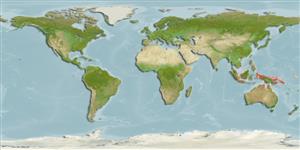Elasmobranchii (tubarões e raias) (sharks and rays) >
Myliobatiformes (Stingrays) >
Dasyatidae (Stingrays) > Urogymninae
Etymology: Pateobatis: Combination of Latin 'pateo' for 'lie open, be exposed' and 'batis' for skate, ray or flatfish; referring to the eclectic nature of members of this group.; hortlei: Named for Kent Hortle..
More on authors: Last, Manjaji-Matsumoto & Kailola.
Environment: milieu / climate zone / depth range / distribution range
Ecologia
marinhas; estuarina demersal; intervalo de profundidade 2 - 7 m (Ref. 58025). Tropical
Western Pacific: eastern Indonesia (Irian Jaya), Papua New Guinea and northern Australia.
Tamanho / Peso / Idade
Maturity: Lm ? range ? - ? cm
Max length : 70.7 cm WD macho/indeterminado; (Ref. 58025); 65.4 cm WD (female)
Descrição suscinta
Morfologia | Morfometria
Distinguished by the following combination of characters: subcircular disc, very angular anteriorly, length 1.1 times DW; pectoral-fin apices broadly rounded; snout extremely elongate, 11-18 times orbit diameter, 96-99° angle; snout to maximum disc width 52-58% of DW; orbit very small, diameter 0.4-0.5 of spiracle length, 3.8-6.3 times in interorbital distance; mouth not greatly protrusible; prepelvic process not expanded; 1-3 enlarged, flattened, pearl-shaped mid-scapular denticles; denticles of main band in two main sizes in adults, crowns plate-like to heart-shaped; dorsal disc uniformly yellowish, brownish, or greyish; ventral surface of adults usually canary yellow in fresh material, often black around oronasal region and gill slits; pectoral fin radials 135-143; pelvic-fin radials 22-28; total vertebral centra 99-108 (Ref. 58025).
Demersal inshore; commonly found over shallow intertidal mud flats and in estuaries in only several metres depth. Viviparous, with histotrophy. Presumably feeds on crustaceans, molluscs and small fishes. Caught regularly, but usually avoided, by beach seine fisheries operating in intertidal habitats. Possibly adversely affected by mangrove loss. Utilized for its meat, and possibly also for its skin and cartilage. (Ref.58048).
Ciclo de vida ou comportamento de acasalamento
Maturidade | Reprodução | Desova | Ovos | Fecundidade | Larvas
Last, P.R., M. Manjaji-Matsumoto and P.J. Kailola, 2006. Himantura hortlei n. sp., a new species of whipray (Myliobatiformes: Dasyatidae) from Irian Jaya, Indonesia. Zootaxa 1239:19-34. (Ref. 58025)
Status na Lista Vermelha da UICN (Ref. 130435)
Ameaça para os humanos
Harmless
Uso pelos humanos
Mais informação
Nomes comunsSinônimosMetabolismoPredadoresEcotoxicologiaReproduçãoMaturidadeDesovaAgregação de desovaFecundidadeOvosDesenvolvimento dos ovos
Idade/TamanhoCrescimentoPeso-comprimentoComprimento-comprimentoFrequências de comprimentoMorfometriaMorfologiaLarvasDinâmica larvalRecrutamentoAbundânciaBRUVS
ReferênciasAquaculturaPerfil para aquaculturaEstirpesGenéticaElectrophoresesHereditariedadeDoençasProcessamentoNutrientsConversão de massa
ColaboradoresFotosStamps, Coins Misc.SonsCiguateraVelocidadeTipo de nataçãoÁrea branquialOtólitosCérebrosVisão
Ferramentas
Relatórios especiais
Baixar XML
Fontes da internet
Estimates based on models
Preferred temperature (Ref.
123201): 27.9 - 29.2, mean 28.8 °C (based on 264 cells).
Índice de diversidade filogenética (Ref.
82804): PD
50 = 0.5312 [Uniqueness, from 0.5 = low to 2.0 = high].
Bayesian length-weight: a=0.00832 (0.00366 - 0.01891), b=3.10 (2.90 - 3.30), in cm total length, based on LWR estimates for this (Sub)family-body shape (Ref.
93245).
Nível Trófico (Ref.
69278): 3.5 ±0.5 se; based on size and trophs of closest relatives
Fishing Vulnerability (Ref.
59153): Very high vulnerability (90 of 100).
